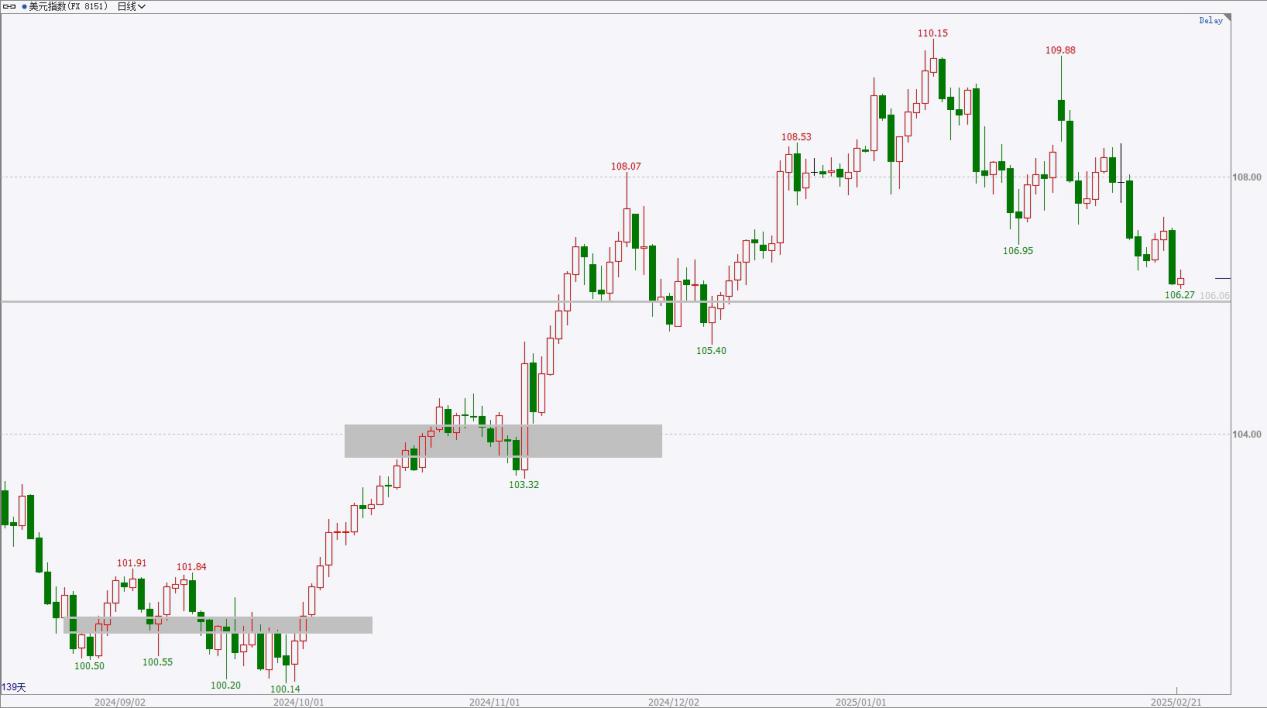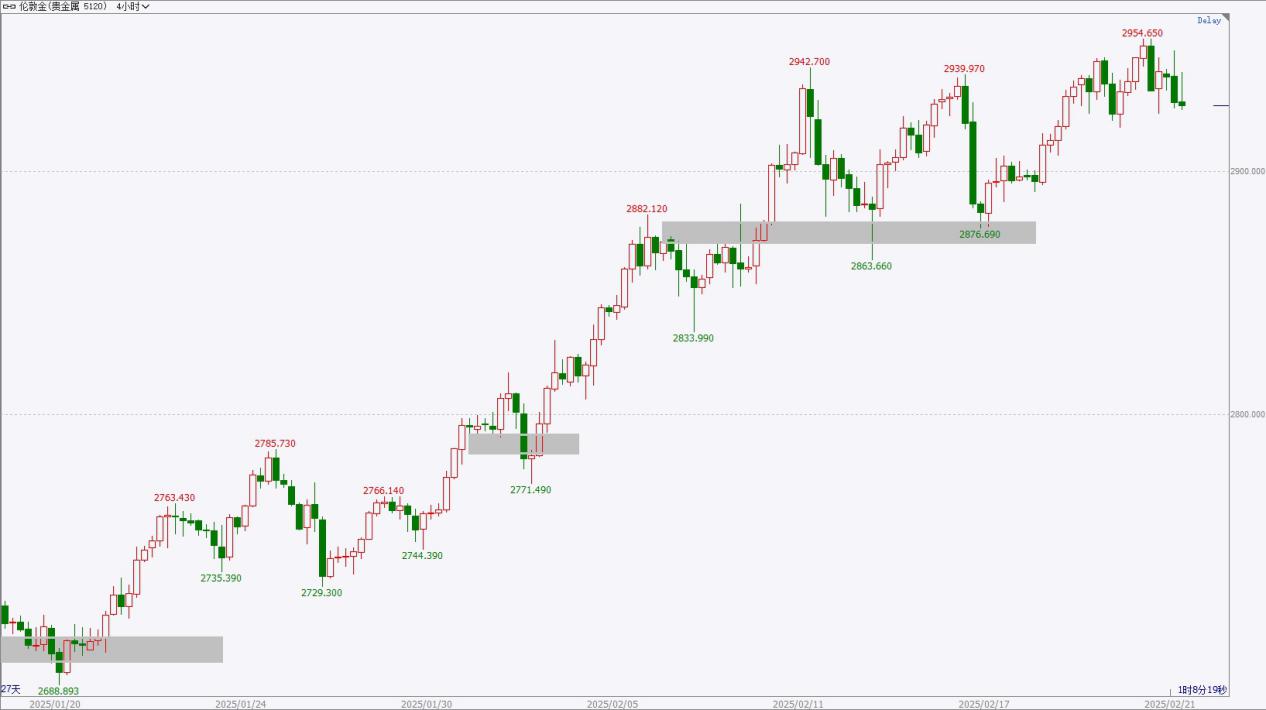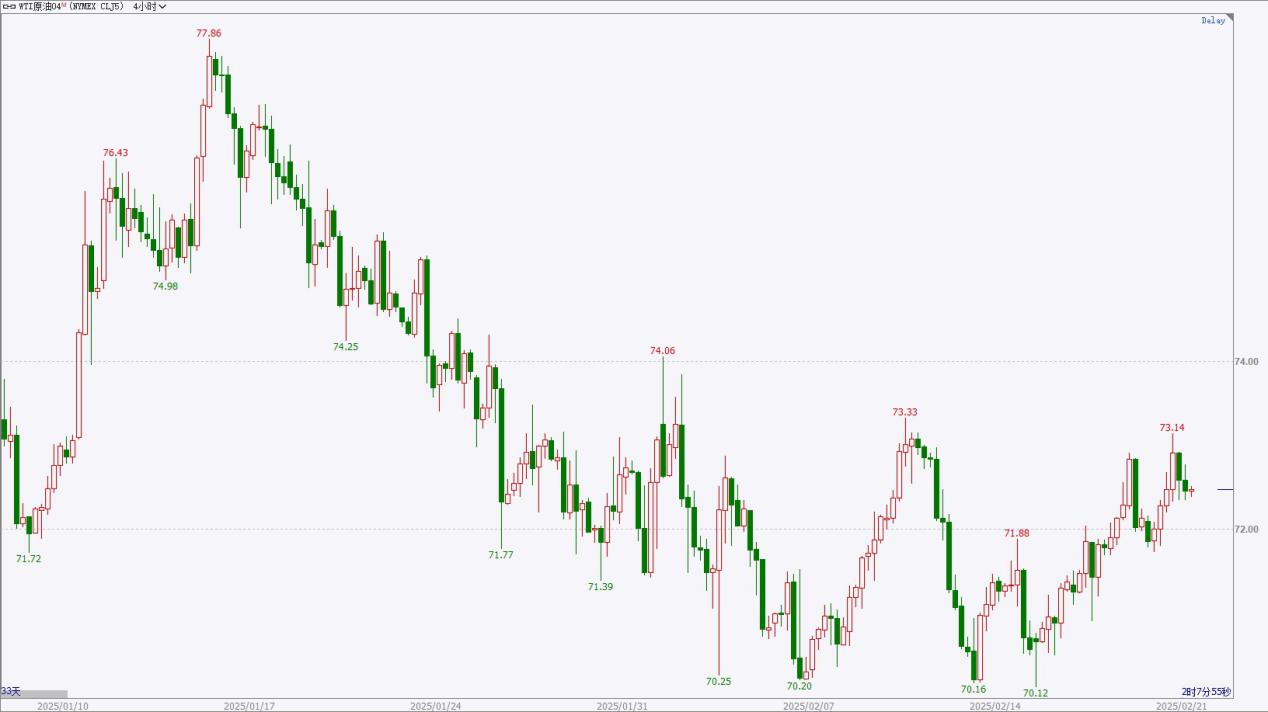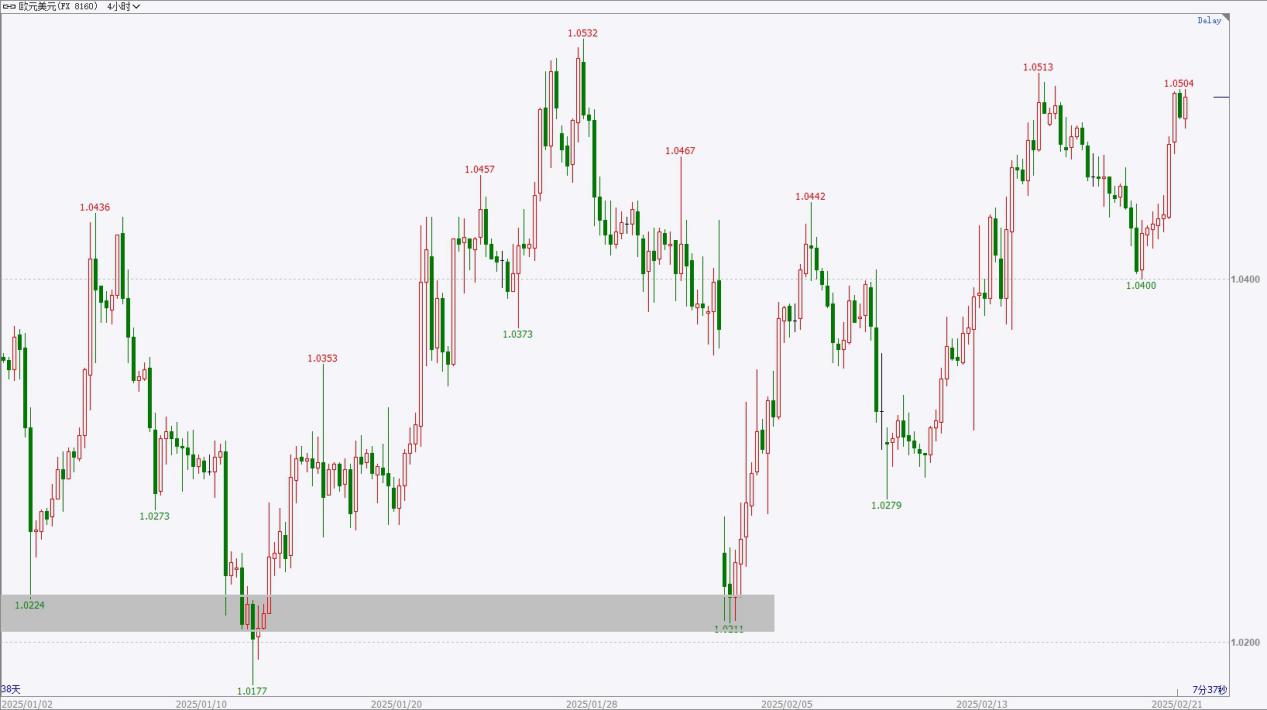|
Time
|
Data and Events
|
Importance
|
|
07:30
|
Japan’s January Core CPI Year-on-Year
|
★★★
|
|
08:01
|
UK February Gfk Consumer Confidence Index
|
★★★
|
|
15:00
|
UK January Seasonally Adjusted Retail Sales Month-on-Month
|
★★★
|
|
16:15
|
France February Manufacturing PMI Final
|
★★★
|
|
16:30
|
Germany February Manufacturing PMI Preliminary
|
★★★
|
|
17:00
|
Eurozone February Manufacturing PMI Final
|
★★★
|
|
17:30
|
UK February Manufacturing PMI Final
|
★★★
|
|
UK February Services PMI Final
|
★★★
|
|
21:30
|
Canada December Retail Sales Month-on-Month
|
★★★
|
|
22:45
|
US February S&P Global Manufacturing PMI Final
|
★★★
|
|
US February S&P Global Services PMI Preliminary
|
★★★
|
|
23:00
|
US February One-Year Inflation Rate Expectations Preliminary
|
★★★
|
|
US February University of Michigan Consumer Confidence Index Preliminary
|
★★★★
|
|
US January Existing Home Sales Total Annualized
|
★★★
|
|
Variety
|
Viewpoint
|
Support Range
|
Pressure Range
|
|
US Dollar Index
|
Fluctuating Weak
|
105.5-106
|
108.5-109
|
|
Gold
|
Fluctuating Strong
|
2850-2870
|
2980-3000
|
|
Crude Oil
|
Short-term Fluctuation
|
69-70
|
79-80
|
|
Euro
|
Fluctuating Strong
|
1.0180-1.0200
|
1.0500-1.0550
|
*Pre-market views are time-sensitive and limited, merely predictive and for reference and study purposes; they do not constitute investment advice, and operational risks are borne by the individual. Investment carries risks; trading requires caution.
Fundamental Analysis:
At the end of January, the Fed meeting maintained interest rates unchanged; the labor market remains strong, economic activity is steadily expanding, and inflation levels still appear slightly high. Expectations for loosening monetary policy have cooled, and attention will be on new government policies. January’s non-farm data showed new employment numbers dropped to 143,000, lower than expected, while the unemployment rate slightly fell to 4.0%, indicating a stable labor market. The unadjusted CPI year-on-year for January recorded at 3.0%, slightly above previous values and expectations. The core PCE price index for December remained flat compared to the previous value; the ISM manufacturing PMI for January rose slightly.
Technical Analysis:

The US dollar index continued to decline yesterday, showing a small cycle of downward fluctuations, with short-term performance leaning weakly and no signs of stopping the fall, suggesting there may still be space for retreat. Attention could be given to opportunities for high short positions during rebounds to make timely profits. Overall, the daily chart shows signs of weakening after high-level fluctuations, with a possibility of continued weak correction in the short term. The upper small-level pressure area is around 108.5-109, while the lower support area is around 105.5-106.
Viewpoint: Fluctuating Weak; a small cycle rebound can be attempted for short-term high positions.
*Pre-market views are time-sensitive and limited, merely predictive and for reference and study purposes; they do not constitute investment advice, and operational risks are borne by the individual. Investment carries risks; trading requires caution.
Fundamental Analysis:
Geopolitical conflicts in the Middle East continue to worsen, while the situation in Eastern Europe is turbulent and uncertain. At the end of January, the European Central Bank decided to cut interest rates by 25 basis points for the fourth consecutive time, with inflation generally in line with expectations, and economic performance still facing pressure. At the end of January, the Federal Reserve maintained interest rates, reporting solid economic activity, though inflation remains elevated, easing expectations for rate cuts. The U.S. non-farm payroll data for January was mediocre, with the number of new jobs decreasing and below expectations, while the unemployment rate slightly fell, coming in just above expectations; January’s CPI year-on-year inching up, slightly exceeding expectations.
Technical Analysis:

Gold prices rose slightly yesterday before pulling back, with a new high reached in a small cycle, though the momentum was moderate. For those with long positions, consider taking profits on highs, as chasing higher prices may not be advisable, and one should be alert to minor corrections. The focus should be on maintaining a low-buy strategy during pullbacks, securing timely profits. In the longer term, the upward structure remains intact, with daily fluctuations trending up, and prices consistently reaching new highs. The upper resistance level may be around 2980-3000, while the lower support level is around 2850-2870.
Opinion: The market is oscillating with a slight upward bias, focusing on short-term buying strategies and taking profits on highs.
*Pre-market views are time-sensitive and limited, merely predictive and for reference and study purposes; they do not constitute investment advice, and operational risks are borne by the individual. Investment carries risks; trading requires caution.
Fundamental Analysis:
The February EIA monthly report maintains global oil demand growth forecasts for this and next year, with a slight adjustment to 2025 oil prices; the OPEC monthly report also keeps global oil demand growth expectations stable for this and next year; the IEA report slightly raised the global oil demand growth forecast for 2025. At the beginning of February, the OPEC+ meeting upheld the previous oil production agreement, with the committee agreeing to gradually increase oil production starting April 1, aligning with previous plans. EIA oil inventories have increased for the fourth consecutive week, with recent data showing considerable volatility that may impact supply and demand structures.
Technical Analysis:

U.S. crude oil prices rose slightly yesterday, with small cycles showing upward fluctuations, currently at a minor pressure level, but not yet breaking through significantly. Caution is advised for potential corrections, with the market possibly maintaining a fluctuating pattern in the short term, focusing on lower support structures, at which point opportunities for low-buy may be considered during pullbacks. Overall, crude oil prices show slight upward bias, with signs of stability at a larger scale, though short-term corrections may be on the horizon. The upper pressure zone is around 79-80, while the lower support zone is around 69-70.
Opinion: Short-term oscillation, with support areas not breached. Focus on stabilization signals to explore low-buy opportunities.
*Pre-market views are time-sensitive and limited, merely predictive and for reference and study purposes; they do not constitute investment advice, and operational risks are borne by the individual. Investment carries risks; trading requires caution.
Fundamental Analysis:
At the end of January, the European Central Bank decided to cut rates by 25 basis points for the fourth consecutive time, with inflation generally in line with expectations, returning to medium-term targets this year, though the economy still faces challenges and may continue to weaken in the short term, with income and policy effects underpinning a recovery in demand. At the end of January, the Federal Reserve maintained rates, reporting strong overall economic performance, easing expectations for further loosening. The U.S. non-farm payroll data for January was mediocre, with a reduction in new jobs, and the unemployment rate slightly decreased, coming in just above expectations; January’s CPI year-on-year showed a slight increase. Attention should be paid to the Eurozone manufacturing PMI values on Friday.
Technical Analysis:

The euro price stabilized and rose in the night market, with the daily line closing with a large bullish candle, and there are signs of a possible breakout in the current pressure area, suggesting that the market may strengthen further, making it a good time to explore low-buy opportunities during pullbacks. Overall, prices are at relatively low levels with daily oscillations indicating potential signals of stabilization at a larger scale. The upper minor pressure area is around 1.0500-1.0550, while the lower support area is around 1.0180-1.0200.
Opinion: Oscillation with a slight upward bias, focus on low-buy opportunities during pullbacks, and watch if the pressure structure can break through.
*Pre-market views are time-sensitive and limited, merely predictive and for reference and study purposes; they do not constitute investment advice, and operational risks are borne by the individual. Investment carries risks; trading requires caution.


Daily Reviews
Our award-winning team of analysts provides keen and insightful technical and fundamental analysis to understand daily market news and investment trading opportunities
HTFX Daily Forex Commentary 0221
Time
Data and Events
Importance
07:30
Japan’s January Core CPI Year-on-Year
★★★
08:01
UK February Gfk Consumer Confidence Index
★★★
15:00
UK January Seasonally Adjusted Retail Sales Month-on-Month
★★★
16:15
France February Manufacturing PMI Final
★★★
16:30
Germany February Manufacturing PMI Preliminary
★★★
17:00
Eurozone February Manufacturing PMI Final
★★★
17:30
UK February Manufacturing PMI Final
★★★
UK February Services PMI Final
★★★
21:30
Canada December Retail Sales Month-on-Month
★★★
22:45
US February S&P Global Manufacturing PMI Final
★★★
US February S&P Global Services PMI Preliminary
★★★
23:00
US February One-Year Inflation Rate Expectations Preliminary
★★★
US February University of Michigan Consumer Confidence Index Preliminary
★★★★
US January Existing Home Sales Total Annualized
★★★
Variety
Viewpoint
Support Range
Pressure Range
US Dollar Index
Fluctuating Weak
105.5-106
108.5-109
Gold
Fluctuating Strong
2850-2870
2980-3000
Crude Oil
Short-term Fluctuation
69-70
79-80
Euro
Fluctuating Strong
1.0180-1.0200
1.0500-1.0550
*Pre-market views are time-sensitive and limited, merely predictive and for reference and study purposes; they do not constitute investment advice, and operational risks are borne by the individual. Investment carries risks; trading requires caution.
Fundamental Analysis:
At the end of January, the Fed meeting maintained interest rates unchanged; the labor market remains strong, economic activity is steadily expanding, and inflation levels still appear slightly high. Expectations for loosening monetary policy have cooled, and attention will be on new government policies. January’s non-farm data showed new employment numbers dropped to 143,000, lower than expected, while the unemployment rate slightly fell to 4.0%, indicating a stable labor market. The unadjusted CPI year-on-year for January recorded at 3.0%, slightly above previous values and expectations. The core PCE price index for December remained flat compared to the previous value; the ISM manufacturing PMI for January rose slightly.
Technical Analysis:
The US dollar index continued to decline yesterday, showing a small cycle of downward fluctuations, with short-term performance leaning weakly and no signs of stopping the fall, suggesting there may still be space for retreat. Attention could be given to opportunities for high short positions during rebounds to make timely profits. Overall, the daily chart shows signs of weakening after high-level fluctuations, with a possibility of continued weak correction in the short term. The upper small-level pressure area is around 108.5-109, while the lower support area is around 105.5-106.
Viewpoint: Fluctuating Weak; a small cycle rebound can be attempted for short-term high positions.
*Pre-market views are time-sensitive and limited, merely predictive and for reference and study purposes; they do not constitute investment advice, and operational risks are borne by the individual. Investment carries risks; trading requires caution.
Fundamental Analysis:
Geopolitical conflicts in the Middle East continue to worsen, while the situation in Eastern Europe is turbulent and uncertain. At the end of January, the European Central Bank decided to cut interest rates by 25 basis points for the fourth consecutive time, with inflation generally in line with expectations, and economic performance still facing pressure. At the end of January, the Federal Reserve maintained interest rates, reporting solid economic activity, though inflation remains elevated, easing expectations for rate cuts. The U.S. non-farm payroll data for January was mediocre, with the number of new jobs decreasing and below expectations, while the unemployment rate slightly fell, coming in just above expectations; January’s CPI year-on-year inching up, slightly exceeding expectations.
Technical Analysis:
Gold prices rose slightly yesterday before pulling back, with a new high reached in a small cycle, though the momentum was moderate. For those with long positions, consider taking profits on highs, as chasing higher prices may not be advisable, and one should be alert to minor corrections. The focus should be on maintaining a low-buy strategy during pullbacks, securing timely profits. In the longer term, the upward structure remains intact, with daily fluctuations trending up, and prices consistently reaching new highs. The upper resistance level may be around 2980-3000, while the lower support level is around 2850-2870.
Opinion: The market is oscillating with a slight upward bias, focusing on short-term buying strategies and taking profits on highs.
*Pre-market views are time-sensitive and limited, merely predictive and for reference and study purposes; they do not constitute investment advice, and operational risks are borne by the individual. Investment carries risks; trading requires caution.
Fundamental Analysis:
The February EIA monthly report maintains global oil demand growth forecasts for this and next year, with a slight adjustment to 2025 oil prices; the OPEC monthly report also keeps global oil demand growth expectations stable for this and next year; the IEA report slightly raised the global oil demand growth forecast for 2025. At the beginning of February, the OPEC+ meeting upheld the previous oil production agreement, with the committee agreeing to gradually increase oil production starting April 1, aligning with previous plans. EIA oil inventories have increased for the fourth consecutive week, with recent data showing considerable volatility that may impact supply and demand structures.
Technical Analysis:
U.S. crude oil prices rose slightly yesterday, with small cycles showing upward fluctuations, currently at a minor pressure level, but not yet breaking through significantly. Caution is advised for potential corrections, with the market possibly maintaining a fluctuating pattern in the short term, focusing on lower support structures, at which point opportunities for low-buy may be considered during pullbacks. Overall, crude oil prices show slight upward bias, with signs of stability at a larger scale, though short-term corrections may be on the horizon. The upper pressure zone is around 79-80, while the lower support zone is around 69-70.
Opinion: Short-term oscillation, with support areas not breached. Focus on stabilization signals to explore low-buy opportunities.
*Pre-market views are time-sensitive and limited, merely predictive and for reference and study purposes; they do not constitute investment advice, and operational risks are borne by the individual. Investment carries risks; trading requires caution.
Fundamental Analysis:
At the end of January, the European Central Bank decided to cut rates by 25 basis points for the fourth consecutive time, with inflation generally in line with expectations, returning to medium-term targets this year, though the economy still faces challenges and may continue to weaken in the short term, with income and policy effects underpinning a recovery in demand. At the end of January, the Federal Reserve maintained rates, reporting strong overall economic performance, easing expectations for further loosening. The U.S. non-farm payroll data for January was mediocre, with a reduction in new jobs, and the unemployment rate slightly decreased, coming in just above expectations; January’s CPI year-on-year showed a slight increase. Attention should be paid to the Eurozone manufacturing PMI values on Friday.
Technical Analysis:
The euro price stabilized and rose in the night market, with the daily line closing with a large bullish candle, and there are signs of a possible breakout in the current pressure area, suggesting that the market may strengthen further, making it a good time to explore low-buy opportunities during pullbacks. Overall, prices are at relatively low levels with daily oscillations indicating potential signals of stabilization at a larger scale. The upper minor pressure area is around 1.0500-1.0550, while the lower support area is around 1.0180-1.0200.
Opinion: Oscillation with a slight upward bias, focus on low-buy opportunities during pullbacks, and watch if the pressure structure can break through.
*Pre-market views are time-sensitive and limited, merely predictive and for reference and study purposes; they do not constitute investment advice, and operational risks are borne by the individual. Investment carries risks; trading requires caution.
Latest Reviews
HTFX Daily Forex Commentary 0819
HTFX Daily Forex Commentary 0815
HTFX Daily Forex Commentary 0812
HTFX Daily Forex Commentary 0811
Choose a Trusted Broker for Trading
Over 300 employees worldwide, more than 1,000 products, top-tier liquidity